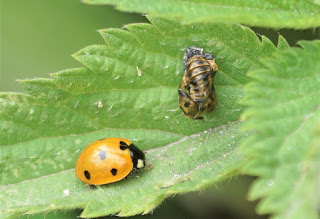I spent yesterday mooching from the fields around St Marys church, up to The Main and then back to the loft room to watch the goings on from the window.
There is so much to see so apologies in advance for the onslaught of photos.
As to be expected in mid June, the butterflies are very noticeable now.
The little lane from London Gate up to the church was alive with one of my favourite butterflies, the characteristic Speckled Wood ...
The dappled shade up the lane is perfect for these territorial butterflies and if you disturb one, the chances are it will fly round in a circle then settle exactly where it first was. It will do the same thing no matter what goes through its 'patch'.
The brambles all along the lane and by the side of St Marys church wall were alive with more butterflies.
Meadow Browns are possibly the most drabby of the british butterflies. They are very adaptable and therefore seen almost everywhere from meadows and hedgerows to gardens and roadside verges.
The one above with it's wings open is a male. The females have flashes of orange on each upper wing. Even on a cloudy damp day, these butterflies will still be out flying around, mating and feeding. They really are hardy little critters.
Nettle patches are favourites of Peacock (more about them further down my blog post) and Small Tortoiseshell butterflies. The patches in the field by St Marys are thankfully left to grow. I'm not a lover of too much neatness and tidiness.
I'm not quite sure what has happened to the upper wing of the Small Tortoiseshell below. It may have not developed properly after emerging from its chrysalis, or it might be battle scars from fighting with another small tort, or it might even be the result of a bird trying to take a bite. It was flying fine though and so long as it creates a new generation, then it's job will be done ...
The bramble banks are also popular with the moth-like Skippers. There are eight 'varieties' of Skipper, but I only saw the two most common ones....
 |
| Small Skipper - possibly Essex Skipper but my photo is not clear enough to say for sure |
 |
| Large Skipper |
 |
| Large Skipper |
 |
| Small Skipper |
Back to the nettle patch.....I found literally thousands of Peacock caterpillars yesterday. The majority of them were in the nettle patches by the side of St Marys church wall, and there were lots up at The Main as well.
 |
| When they have eaten all the young nettle leaves within their web, they break through the silk netting and wander off to find fresh food... |
 |
| more caterpillar poop |
Each butterfly species has caterpillars suited to its habitat. Some butterflies lay only single eggs, yet others like the Peacock lay eggs in clusters.
Another critter that I find fascinating is the humble Ladybird. As mentioned in my last blog post, they have four stages in their short lives...egg, larva, pupa and adult. I only spotted two species of ladybird yesterday, the common 7-Spot and the non-native Harlequin.
 |
| 7-Spot larva |
 |
| 7-Spot larva |
 |
| Harlequin larva |
 |
| 7-Spot adult and pupa shell |
 |
| 7-Spot adult |
Loads of my favourite prehistoric looking Dock Bugs were out in the brambles and nettles too ...
And this beauty below was found on the thistles up on The Main. I think it is a Hawthorn Shieldbug but am happy to be corrected ...
It was a bit too warm yesterday for many hoverflies to be out. They general like conditions a little cooler but there are exceptions ...
 |
| the common 'Marmalade' fly - Episyrphus balteatus |
 |
| Chrysotoxum bicinctum |
The Main was alive with damselflies. They were on the paths, the plants and flitting everywhere. I could only see Common Blues, but I bet there are more species there....
Back at the loft room, I've mentioned before about a Red Kite that is consistently perching in the trees at the back of the field. It calls a lot, flies off a lot but always comes back to the same line of trees. It also seems to enjoy sitting in the rain, as my photo below shows....
and this is the same bird earlier today ...
The jury is out on whether this is an immature bird, maybe one of last years young. Or if it has a nest nearby and has a partner that is brooding eggs or chicks. Or if it is being fed somewhere nearby and is loitering waiting for 'dinner time' ….
Another regular seen from the loftroom window are the Muntjacs. There are two males in the field, both of which have lost their antlers. This is the younger of the two. The first three photos were taken yesterday evening, and the last three were taken earlier this morning (hence the light and photo quality)
The House Sparrows that nest in the field seem to be having a very good fledgling season. There were loads of youngsters out last week, and this morning I was watching a very newly fledged chick being fed by it's Dad ...
A very enjoyable couple of days in Harefield, and it's going to get even better ! High season on The Main should be great for the butterflies as there are plenty of thistles and large globe thistles still to bloom.





























No comments:
Post a Comment